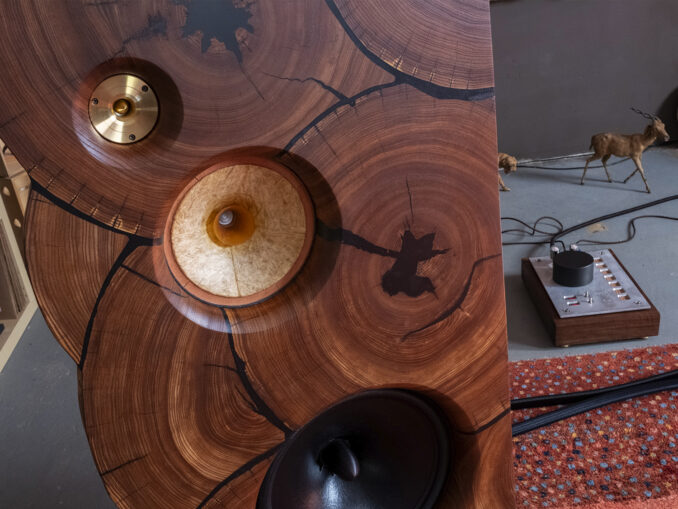
Trees, ‘hauses, audio, and labs are some of my favorite words as they, when combined, bring to mind all manner of lovely hifi things past and present.
And these words weren’t chosen at random, their references to wood, vintage German hifi from companies like Siemens and Klangfilm, audio, and Japanese hifi that comes from labs or laboratories are all part of the Treehaus Audiolab story, which to my mind is part of the ‘Phantom of Luxury’ Field Coil Loudspeakers complete picture. If you aren’t interested in the parts that make up the whole, why they were chosen and where they’re from, you might find it hard to understand the full appeal of a speaker called ‘Phantom of Luxury’. [footnote 1]

Rich Pinto is Treehaus’ proprietor and in a way you can think of him as master craftsman and master mixer, fashioning baffles from slabs of wood, filling them with select drivers from around the globe, and choosing the exacting mix of power, cables, minimal crossover and a DSP-based external crossover for the 15″ Acoustic Elegance Dipole15 Woofers to turn the sum of the parts into a unified music-making whole.
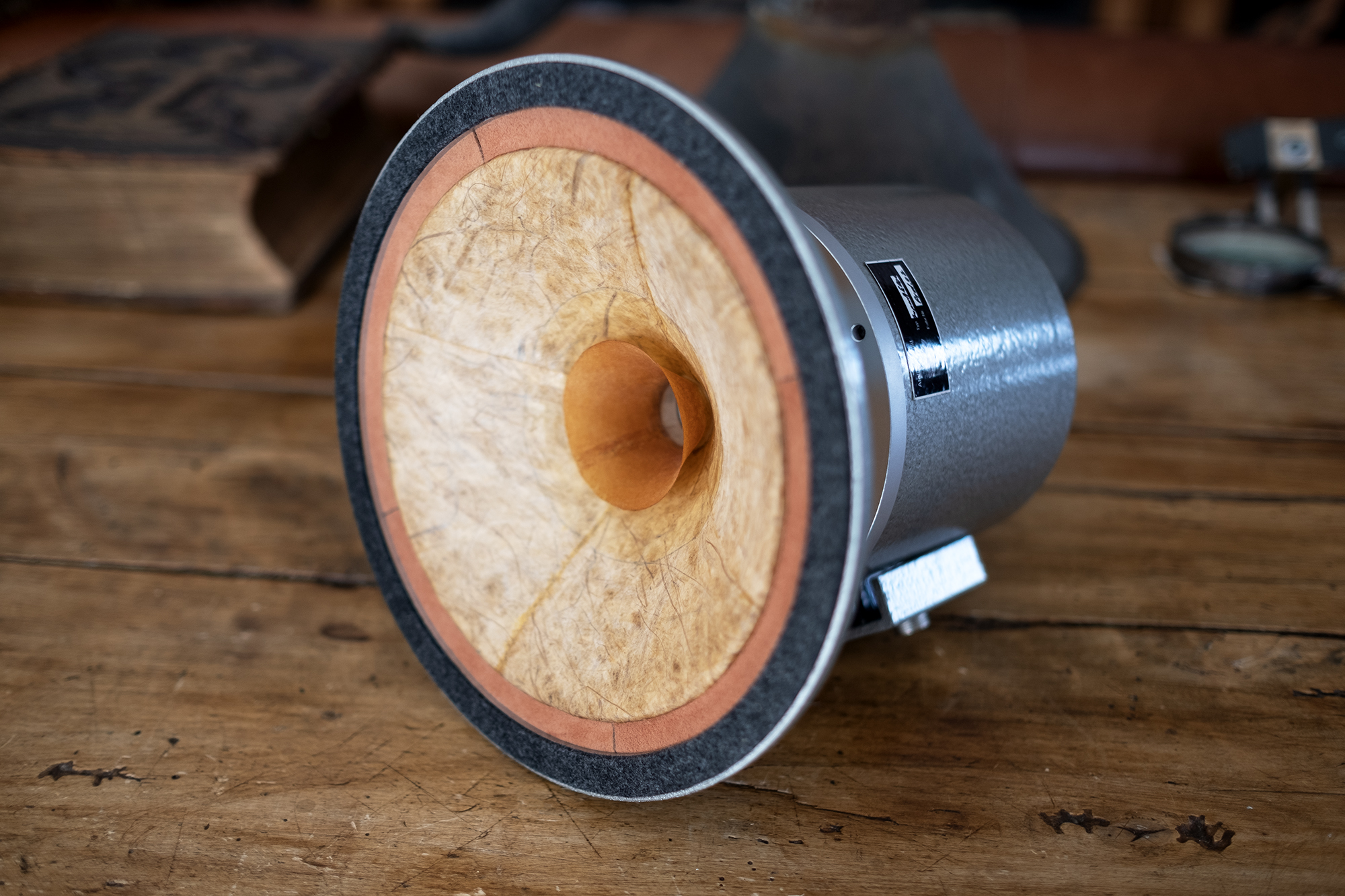
The beating heart of the ‘Phantom of Luxury’ are the 100db efficient Atelier Rullit 10″ Super Aero full-range field coil drivers, which run from 80Hz to about 14K here before handing off to the Fostex T900A super tweeters, and are built by Oleg Rullit of Germany using rebuilt/redesigned/repurposed vintage field coils from Klangfilm and Telefunken combined with Rullit’s handmade whizzer-endowed cones made from a lightweight paper with a leather surround. I’m being purposefully vague here as I’ve seen a number of different ‘recipes’ for these cones so I chose to err on the side of being less specific.
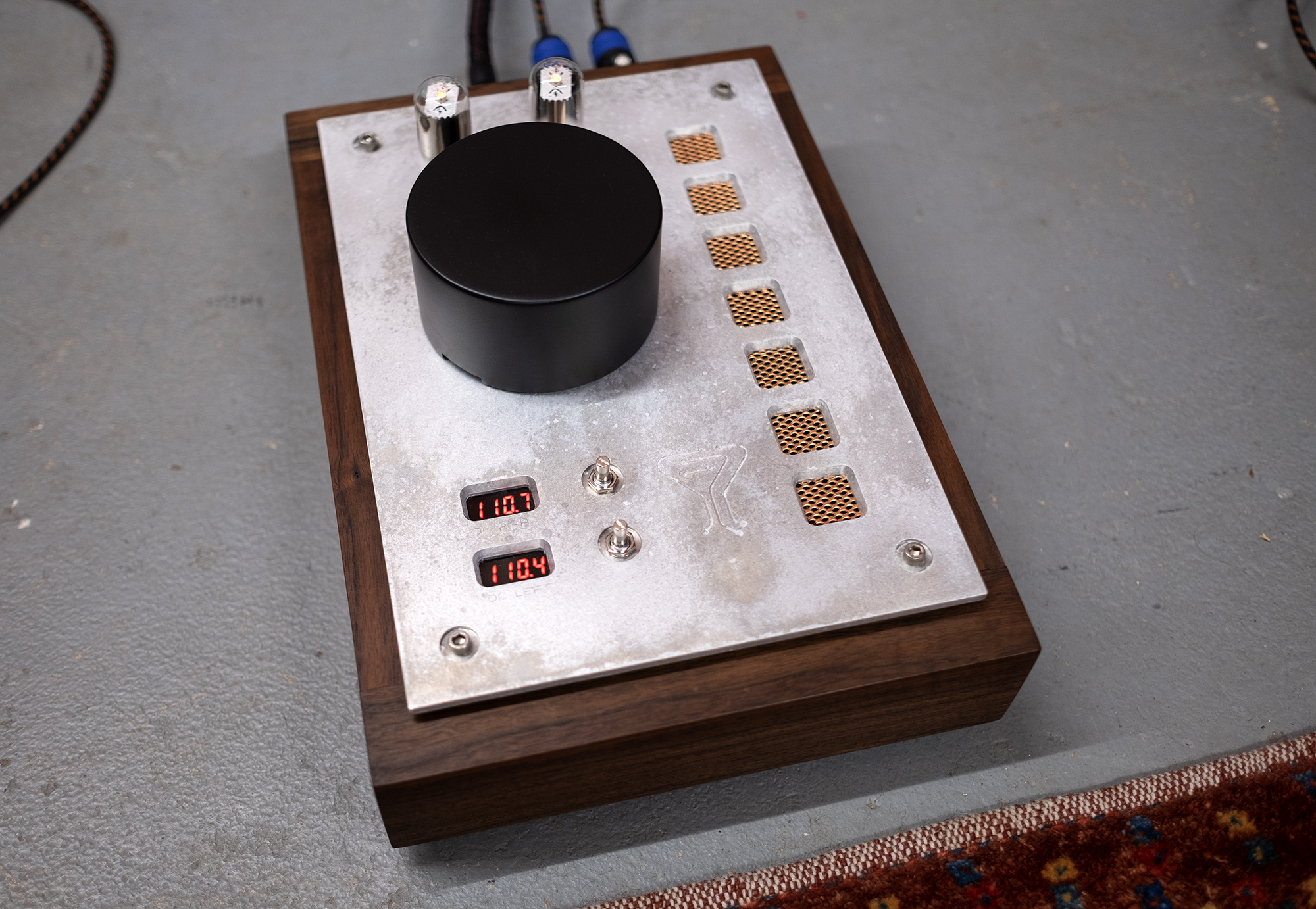
As is the case with all things hifi, what you choose to power a field coil with, a field coil is an electromagnet in need of current to create the driver’s magnetic force, will effect the end result and the Phantoms come with a Treehaus designed and built tube rectified (6CJ3 TV diode dampers) field coil power supply which is also user adjustable by turning those rotary switches with the handy level LED displays to tune the character of the full range driver—Lower voltage: more relaxed sound, slightly less efficient. Higher voltage: tighter sound, more efficient—according to Treehaus. I did give those switches some turns and found the changes in sound subtle but welcome and it’s worth highlighting the output of each driver in the Phantoms can be tailored to taste.

The business side of the Phantom’s is open to the public and includes two pair of Cardas binding posts, with one pair serving the Atelier Rullit/Fostex combo and the other serving the woofers. There’s a knob to dial in the super tweeter level as well as the power inlet for the field coil PS. Being an open baffle, the business end also provides an open view of the minimal crossover for the super tweeter as well as the upgraded Iconoclast SPTPC wire that ties everything together.
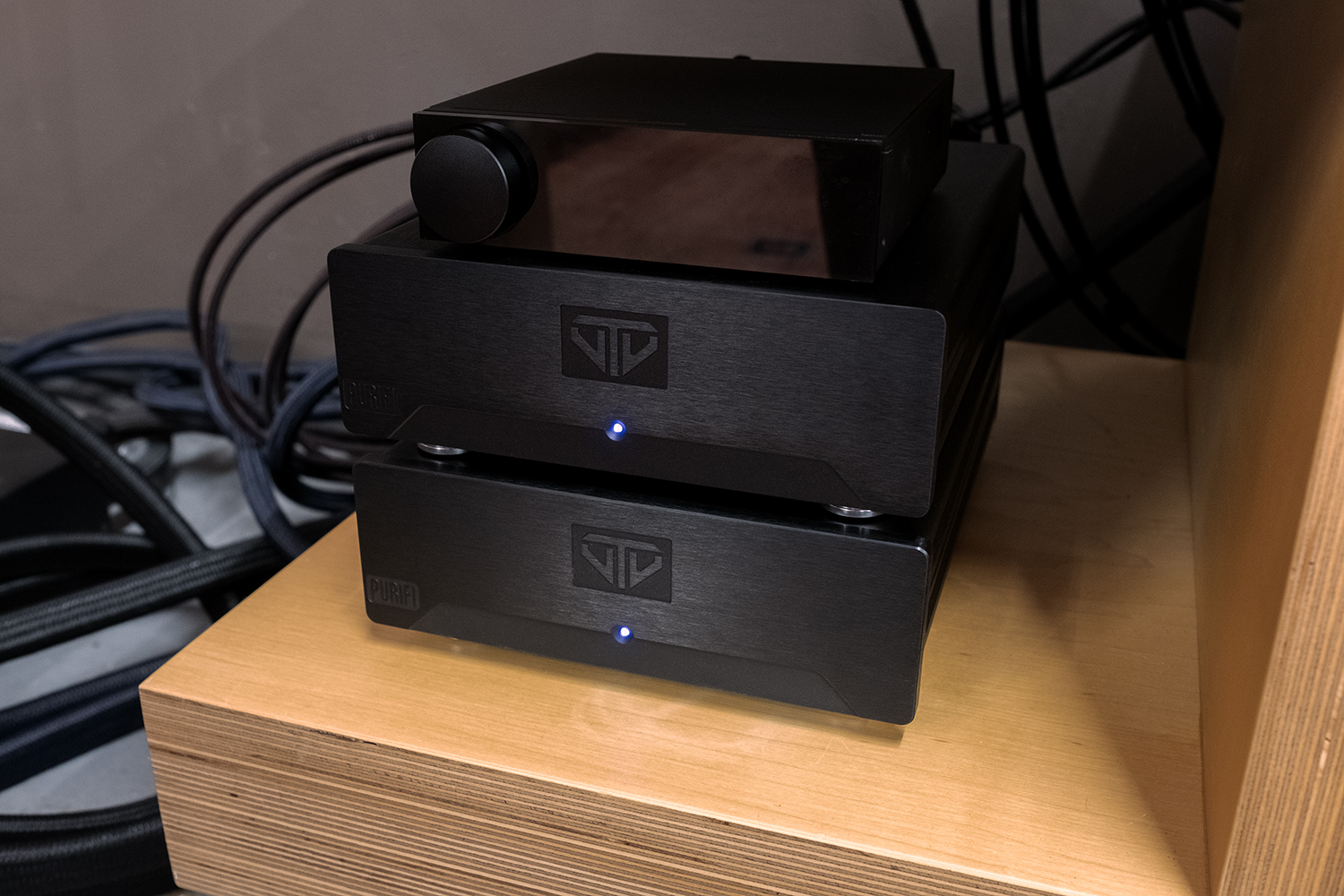
Treehaus supplied a pair of VTV Purifi Monoblock amps to drive the Phantom’s woofers along with a miniDSP FLEX audio processor for setup and control of the rolloff point and woofer level. The setup process involves using Room EQ Wizard (REW) software and a calibrated microphone to measure in-room response and adjust for any lumps and dips. Rich performed this relatively simple set up and I’m happy he did because I enjoy using REW or Dirac or whatever DSP tool about as much as I enjoy maintaining our water treatment system that resides in the dank, dark cricket graveyard recesses of our otherwise finished basement. Joking aside, this is a very useful tool in the real world where the perfect room, and the prefect in-room response, doesn’t exist especially when dealing with the output from a 15″ woofer per side. Nice.

Once set up, the miniDSP’s included remote allows for woofer level adjustment to taste. And while we’re here, I don’t know anyone—who knows what they’re doing—who uses the measured in-room results as spit out by software as there’s always tweaking to taste that needs to be done to make music sound…better.
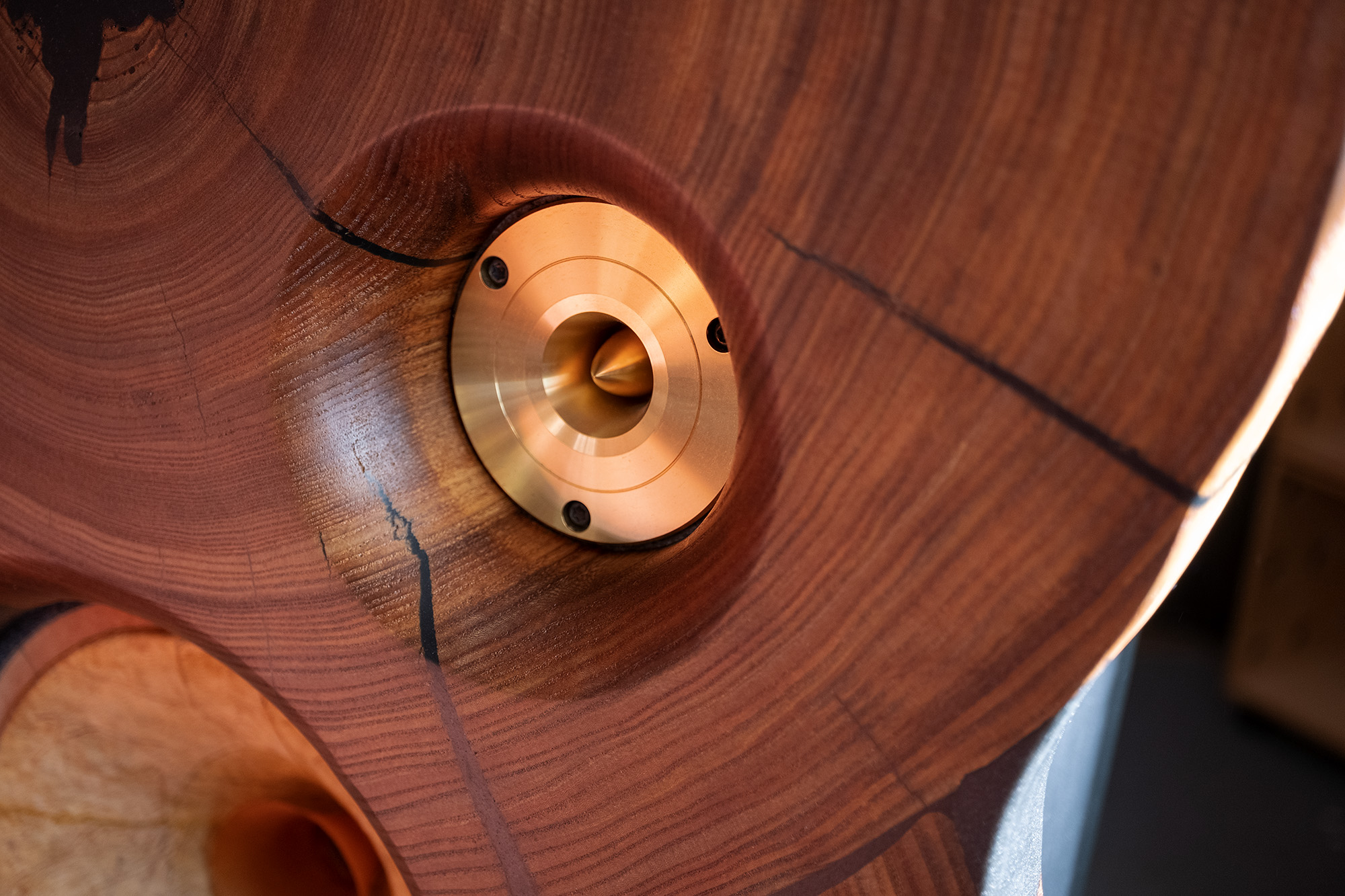
Anyone with the time, curiosity, and the internet can search for some of the raw parts that make up the ‘Phantom of Luxury’ Field Coil Loudspeakers. Those Atelier Rullit drivers are sold direct on eBay for $9700/pair + shipping (includes a field coil power supply), the Fostex T900A Super Tweeters are easy to find for about $1200/pair, and you can buy the Acoustic Elegance Dipole15 Woofers direct for $659 apiece. Yea, we’re at $12,000+ and all we have are a pile of drivers. One thing some wannabe DIYers never seem to calculate into their wannabe DIY builds is the value of time. I suppose if I spent hours of my life most days complaining about the price of things online, I’d forget to value my time too. [footnote 2]
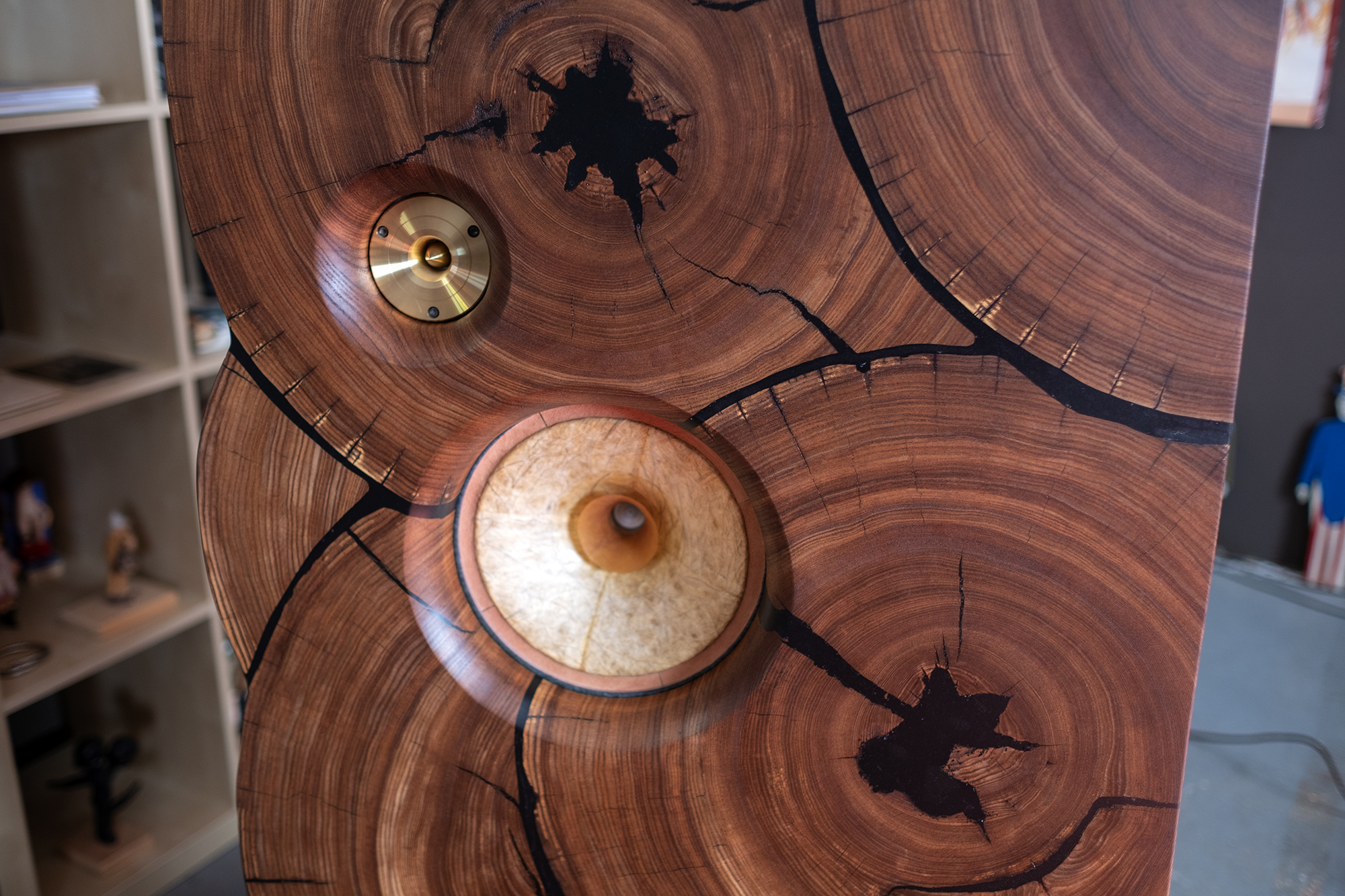
The set up:

Let me see if I can make this as simple as possible with words—the ‘Phantom of Luxury’ Field Coil Loudspeakers are meant to be bi-amped, which is why Rich included those VTV monoblocks for the woofers. For most of this review, I used the recently reviewed Triode Evolution 300 integrated amp’s Pre In (review), turning it into a power amp, along with the recently reviewed (and stunning in every way) Grimm MU2 (review) as a complete digital source and preamp. In order to get that single Preamp out from the Grimm into both the VTV monoblocks and the Triode Evolution 300’s inputs, I used a set of AudioQuest Y splitters that take a single RCA male input and splits it into two RCA female outputs so one set of interconnects went to the miniDSP FLEX’s inputs while the other went to the Triode’s Pre In. The miniDSP’s outputs fed the VTVs. Simple?
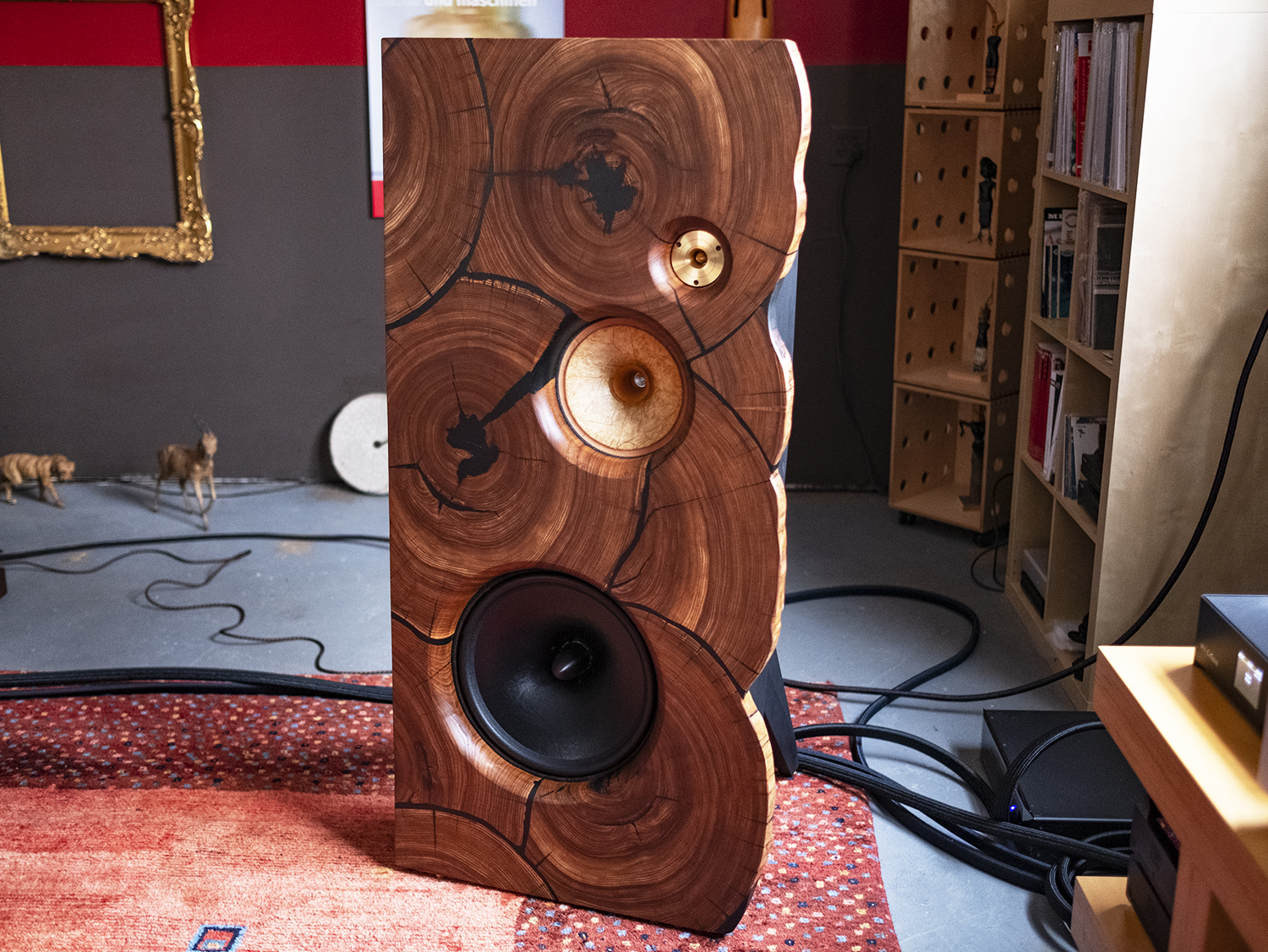
The Elm Cookie baffles on the review Phantoms is an upgrade (+$3000) over the standard Walnut or Elm live edge baffle and I think my eyes prefer the relatively simpler live edge look, but I may just have a thing for slabs. Each pair of Treehaus Audiolabs speaker are essentially one-of-a-kind in this regard as mother nature abhors sameness. But the Big Question on most people’s minds when they first see a ‘Phantom of Luxury’ Field Coil Loudspeaker is—How do they sound? Luckily, I have some things to say about exactly that!

It’s also worth noting that Treehaus makes 300B-based SET amplifiers as well as a preamp and MC Step Up transformer, which is where the “lab” comes in as their approach is based on Japanese sources like the late Susumu Sakuma. With all that in mind, I’d love to see a Treehaus package that was, more or less, plug and play—preamp/amp/speakers. I’d even throw in a rack option to boot.

The following listening notes were written after living with the Phantom’s for just over a month, where they resided on the Barn’s A-Side exclusively (and never moved). I’ll also add that I’ve got some experience with multi-driver speakers that run with a full range driver as well as single driver speakers having owned and reviewed a bunch of the latter, like the Cain and Cain Abbys, (remember those?), Auditorium 23 SoloVox, and Lamhorns (remember those?), and I’ve reviewed a bunch of the former including the recently reviewed Zu Definition 6 (review) and Rethm Aarka Active Speakers (review). To name but a few. [footnote 3] And there’s at least one thing they all have in common and that is the ability to present the meat of music as an energized source that projects, like a ball of energy, out in front of the speakers. Tactile. Eery.
One foggy morning near the end of this review period, Roon Radio found its way to play “Girl from the North Country” from The Freewheelin’ Bob Dylan, his sophomore release from 1963 (yea, even Dylan was a sophomore at one time). And I was so taken, and taken back, with this music I decided to play the entire album. And before anyone begins to think I’m making some statement about the kind of music the Phantoms are ‘good at’, any speaker worth its salt will play all kinds of music really well, which is the case here. But, the Phantom’s standout strengths make this kind of music, music made with an acoustic guitar, harmonic and vocals feel vibrant, present, and alive.
Which gets me back to the ‘Phantom of Luxury’s’ beating heart of a driver, the Atelier Rullit 10”, because the bulk of the sound contained in Freewheelin’ came out of those full range drivers, with the super tweeters and woofers acting as minor supporting cast. With the Triode Evolution 300B driving that full range driver, Dylan’s one man band sounded rich, full, and lit up with life-like energy in Barn and projected into space in some ways hitting my ears very nearly like a pair of giant headphones. The Atellier Rullits have no discernible peak or peakiness that can haunt some full rangers—SHOUT—while being very resolving and wonderfully rich. Color me impressed.
Mannequin Pussy’s I’ve Got Heaven, released on Epitaph earlier this month, is unrestrained fury in sound and one of my favorite records of the year (so far). It’s also self-assured well beyond giving a fuck and as in your face as music gets. Punchy, powerful, and playful with a menacing manner, I’ve Got Heaven feels like a soothing balm for the mind-numbing endless flow of our normalized beyond the pale current events. Played loud and louder still, the Phantom’s also ‘get’ this kind of hard-driving crush of sound as well as the more delicate bits, filling the Barn with Mannequin Pussy’s manic energy. I’ve Got Heaven builds masses of sound from guitars, synthesizer, bass, drums, and vocals at times growing into massive crescendos of near mayhem and this energy, this force, was propelled into the barn by this system with gut wrenching seamless glory and thanks to the field coil power supply’s voltage level adjustability, you can dial in more tightly gripped guts or a softer focused bloom to suite your fancy. While we’re here, I’m not a forever fiddler type so when I find the sound I prefer, I leave things alone and the Phantoms were pretty much dialed in during initial setup with some very minor level tweaking for the Atelier Rullit Super Aeros when I changed from the Audionet HUMBOLDT (review) to the Triode Evolution 300.
Lados B from drummer Daniel Villarreal, guitarist Jeff Parker, and bassist Anna Butterss was released on International Anthem last year and it’s a lovely Latin percussion inspired jumpy jazz fest. The masterful interplay and distinct voices of this simple ensemble were reproduced in Barn by the Phantoms with every micro-movement from Villarreal’s percussion, Parker’s at times over-driven six string excursions rooted by Butterss bass feeling ripe and present. And that bass, open baffle bass, is something to be experienced for its combined strengths of deep reach and free-flowing form. This music lives in and loves timing and the Phantoms deftly move with whatever flow you throw their way.
“Darling the Dawn” from All Hands_Make Light, released on Constellation Records last year, is a dream of a record, building airy sound structures from Ariel Engle (La Force, Patrick Watson, Broken Social Scene) on vocals and Efrim Manuel Menuck (Godspeed You! Black Emperor, Thee Silver Mt. Zion) on “noise”, joined by Liam O’Neill on drums and Jessica Moss on violins. A charming respite from I’ve Got Heaven, “Darling the Dawn” is like Vangellis sprinkled over Can, all awash in atmosphere.
From the liner notes:
Above all it’s the singing and lyrics, in method and melodic delivery, that conjure certain freak-folk furrows. Engle calls this “music inspired by ancestor music, sea shanties for seas we’ve never sailed” and the duo have indeed forged a collection on “Darling The Dawn” where vocals often feel strangely rooted in traditionals, while the instrumentation resonates out-of-time, in a liminal space at once glisteningly synthetic and oxidized in analog patina.
Analog patina indeed. It’s here, within the reproduction of billowing atmospheres, that the Phantom’s speaker-forward presentation came into sharper focus. What I mean by this is the bulk of sound energy in-room felt as if it originated from the speaker forward as opposed to the complete and total disappearing act a speaker like the similarly priced Rockport Atria II (review) pull off with seamless mastery that makes reproduced music sound as if it is the origin of itself—in space. Another way to say essentially the same thing is I never felt as if the Phantoms completely disappeared, even with my eyes closed. In some ways, this is about preference in presentation and this speaker forward sound can also be heard from horns and admirers obviously prefer this type of pushy energy.
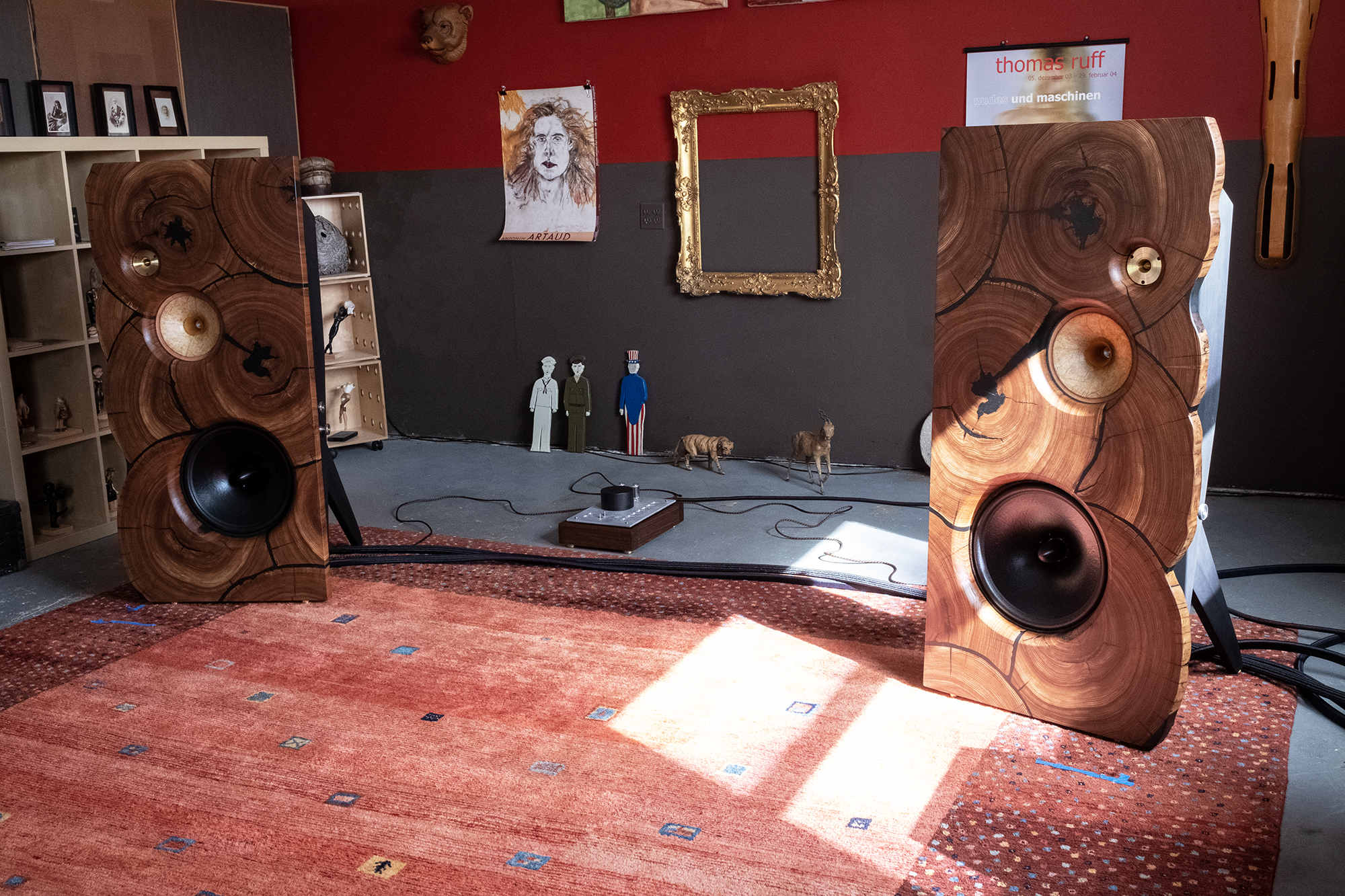
That being said, the Treehaus Phantom’s do have a phantom-like quality in that they create a compellingly tactile presence with the beating heart of music feeling rich and harmonically right with delicate beauty and/or guts and heart-pounding glory morphing with the music in play. And there’s no denying the Phantom’s stunning unusual looks which I find appealing—I appreciate the art and craft involved—and they essentially act as an initial litmus test for potential buyers to a greater degree than a ‘traditional’ box speaker. And let’s not forget that each driver comes with its own output control from the field coil power supply’s voltage level for the full range Atelier Rullit drivers, to the level control for the super tweeters, and the outboard DSP-based control for the woofers.

The Treehaus Audiolab ‘Phantom of Luxury’ Field Coil Loudspeakers are an accumulation of parts masterfully mixed with original designs built into truly lovely one-of-a-kind baffles. To my mind, people attracted to their appearance and approach rooted in hifi history will find the Phantom’s also deliver the sonic goods by reproducing music with a rich live-like vitality, engaging in-room energy, and a tactile compelling presence with the added benefits that come with the ability to tune each driver to room and taste, all told telling captivating stories in sound.
- Rich from Treehuas pointed out—”The Treehaus Logo is a tree, in a T shape, the lines reference schematics and circuit traces, and the whole thing is an upside-down Erlenmeyer flask.” My repeat viewings of Breaking Bad should have clued me in to that last bit.
- I also want to give a special shout out to those audiophile types who think they know more than they know and what’s worse they value what they think they know more than what people who actually know have to say. How can you find one of these misguided misanthropes? Look for people who dismiss speakers based on a photo.
- When I first started writing about hifi for 6moons back in 2005, my mission was to focus on low power amps and high efficiency speakers so I spent some time tracking down and listening to a bunch including the Carfrae Little Big horns, Hørning Alkibiades, Shindo Latour field coil speakers, Shindo WE 755, and a JE Labs style Open Baffle using Hartley 310s full-range and Jensen RP-302 supertweeters to name a few more.
Treehaus Audiolab ‘Phantom of Luxury’ Field Coil Loudspeakers
Price: starts at $29,000/pair for Walnut or Elm live edge baffle and Canare OFC star quad wiring. The Elm Cookie baffle adds $3000 and the Iconoclast SPTPC internal wiring adds $3500. Other custom options are available.
Size and weight: 54”H x 26”W X 24” D | 130lbs/ea.
Company Website: Treehuas Audiolab

